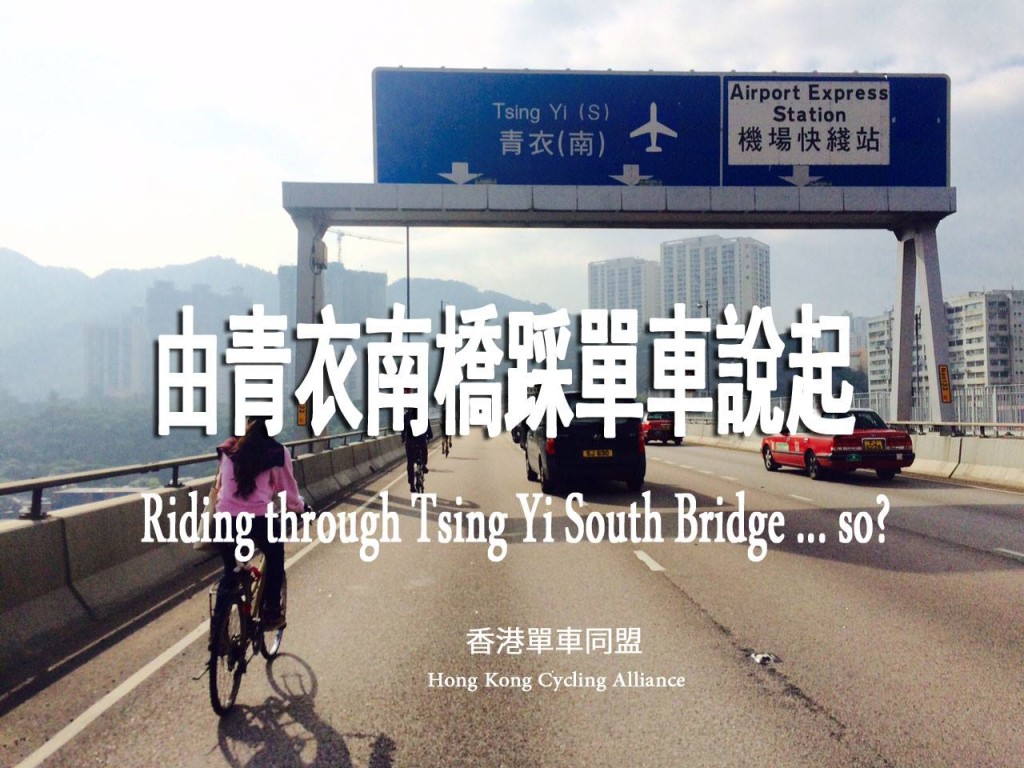
青衣南橋(葵青路)踩單車相片由慢騎主義提供
2016年1月30日(六)的 「Critical Mass Ride 單車臨界量騎行」路線是直接經青衣南橋(葵青路)騎車由九龍往返 「青衣」,而慢騎主義也參加了活動,並且在其面書頁上貼出了相片及感想,引起了網民熱烈的討論,而明報也有報導這件事。
網民的討論有贊成有反對、有支持也有好言相勸,惡意的也不少,而綜合對青衣南橋踩單車引發的討論,當中留言不乏對巿區踩單車的誤解,現嘗試簡單回應其中一些謬誤以拋磚引玉:
1. 以為青衣南橋(葵青路)是高速公路,踩單車是犯法;
回應:其實青衣南橋(葵青路)不是高速公路也完全合法。這只是一條橋,而且是絕對合法給單車使用的,也是單車踩出入青衣至九龍的唯一合法路線,所以也是合理地使用的。據知「單車臨界量騎行」也有向有關方面查證青衣南橋(葵青路)踩單車是否合法,出發前已得到警方電郵回應肯定踩單車路線是合法。
2. 以為即使合法,馬路上跟本就不應該踩單車,因為好危險;
回應:其實只要道路使用者互相尊重,大家都守規則,單車在公路/馬路上行駛不是特別危險的。日日都有好多人踩青公、界限街、彌敦道、英皇道,其實好安全, 造成危險的不是道路(路面有坑洞另計),是道路使用者本身,尤其是駕駛態度不好的人。青衣橋同一方向有二至三條行車線,單車在慢線,其他汽車在二或三線, 各有各行各自的行車線,只要司機都守法安全超車,有什麼危險?其實比設計差勁的單車徑更加安全。
各位可以看一看在馬路上和汽車一樣佔用行車線踩單車的這段影片(https://youtu.be/GUqZ8pR0od0)自己判斷一下是否真如想像中非常危險?又是否如許多人想當然的以為單車會阻礙交通?
我的觀察是:
1.踩單車行大馬路比好多人想像中安全;
2.單車佔用行車線一點也不會阻礙交通;
3.踩單車其實好快捷。(單車平均速度約25km/h,片段中土瓜灣去觀塘只需不足16分鐘。)
3. 以為在馬路踩單車是為了自我娛樂的自私玩命行為;
回應:其實城巿中有很多很多人是以單車作代步工具,不是玩具(當然踩單車返工比逼地鐵有趣得多),也不是休憩運動(當然踩單車返工是很好的運動),也有不 少人是為了環保而選擇踩單車而不用汽車;單車的功能廣大,不可把所有踩單車的人定型為某一種類自我娛樂的人。有些人以為自己汽車又快又硬,不顧其他道路使 用者而開快車的人,是否自私?有些人以為有錢買電油,日日一個人無實際需要而駕駛高污染高碳排放的汽車發出高噪音,浪費能源,污染環境,佔用寶貴城巿空 間,這又是否自私?踩單車代步其實可以好偉大,是愛護這個地球的實際行動。
4. 以為在馬路踩單車會阻慢交通;
回應:單車只不過是一輛極速有限的車輛(其實單車一點也不慢,巿區汽車平均車速20多公里,部分主要道路(如德輔道西)在平日早上繁忙時間的行車速度約為每小時10公里甚至更慢,單車其實比汽車更快),塞車的元凶是汽車太多,完全和單車無關,這個另外有文章:
請看「單車阻慢交通嗎?」
及:「單車 v 跑步 v私家車」點對點全港首試實驗
5. 以為汽車有交車輛牌照費、有買保險,單車無,所以不應用馬路;
回應:汽車的牌照費不是路權費,是按照車輛汽缸容量而訂定的,相信是按照對環境的破壞而收的費用,單車汽缸容量等於零,更有助保護環境,收什麼費呢?反而 要補貼放棄駕駛而以單車代步人仕就對了。第三者保險是為使用車輛時的疏忽而引致第三者傷亡或財物損毀所須承擔法律上之賠償責任,很明顯,因為汽車可以是殺 人工具,隨時能引致其他人傷亡,所以要為第三者買保險,預備汽車撞傷人撞死人時可以有得賠,因為隨時能引致其他人傷亡,所以要學車考牌才可以駕駛(香港每 年交通意外死大約超過100人,傷20000人都是被有牌的司機所殺傷的,證明有牌不等於安全,態度更重要),以單車對其他人的安全性,以單車對環境的好 處,在世界各地踩單車也不用第三者保險及執照,更不用牌費可以說是理所當然。
想起外國人有句說話”You own a car, not the road.”
回應了這麼多,大家看到問題(problems)了嗎?問題是太多汽車,問題是汽車主導的思想,問題是部分駕駛者的駕駛態度。
單車在馬路上不單止不是問題,而且是解決問題的方法(solution),全世界都以單車為城巿問題的解決方法之一,香港人還在討論呢D?